Introduction
The DJI Inspire 1, manufactured by SZ DJI TECHNOLOGY, has been a benchmark in professional aerial photography and videography drones. Designed primarily for capturing high-quality aerial footage, the Inspire 1 has become synonymous with reliability, exceptional stability, and advanced flight features. With its FCC certification under FCC ID SS3-WM6101410, the Inspire 1 has proven compliance with stringent electromagnetic interference and RF emission standards set forth by the FCC, ensuring it is legal for sale and use within the United States.
FCC ID SS3-WM6101410 indicates that this drone has undergone rigorous testing to comply with FCC Part 15C rules governing intentional radiators, meaning it meets the necessary emission standards for safe and interference-free operation. This certification not only ensures the device’s regulatory compliance but also underscores DJI’s commitment to quality and safety.
In this article, we’ll dive deep into the DJI Inspire 1’s key specifications, analyze its internal components through a detailed teardown, explore its wireless capabilities, and provide insights into its FCC regulatory filings.
Key Features & Specifications
While DJI has not extensively published detailed official specifications for the Inspire 1 (Model: WM6101410), typical expectations for a drone of this caliber include:
- Advanced Flight Control System: Ensures stability and precise maneuverability.
- High-Quality Camera System: Equipped with a CMOS sensor camera module, capable of capturing stunning aerial imagery and video.
- GPS Navigation: Integrated GPS module (Ublox M8N) for accurate positioning, return-to-home functionality, and autonomous flight capabilities.
- Modular Design: Enables easy repair, upgrade, and customization.
- Powerful Propulsion System: Optimized motors and propellers for efficient, stable flight performance.
- Wireless Connectivity: Operates within the 2.4065-2.4765 GHz frequency range, delivering robust communication and control signals.
The Inspire 1’s operating frequency and power details from the FCC filing are as follows:
| Frequency Range (GHz) | Output Power (mW) | FCC Rule Part |
|---|---|---|
| 2.4065-2.4765 | 255 | 15C1 |
This frequency band is commonly utilized for Wi-Fi and Bluetooth communications, providing reliable control and data transmission capabilities while adhering to FCC rules regarding intentional radiators.
Technology Deep Dive
The DJI Inspire 1 primarily utilizes 2.4 GHz wireless technology, a frequency range widely recognized for Wi-Fi and remote-control applications. Operating within 2.4065 to 2.4765 GHz ensures robust wireless connectivity, offering an optimal balance between communication range, data throughput, and interference management. At 255 mW output power, the Inspire 1 achieves considerable range and signal penetration while remaining compliant with FCC Part 15C regulations.
This frequency choice ensures minimal interference from common household devices, balanced power consumption, and reliable performance even in RF-congested environments. The drone’s wireless module is engineered for precise control responsiveness and real-time video streaming, essential for professional aerial photography and videography.
In-Depth Internal Component Analysis / Teardown
The Inspire 1 incorporates several compact, carefully designed PCBs, each serving specialized functions. The circular PCB analyzed shows a dense arrangement of ICs, likely microcontrollers and power management chips, optimized for space efficiency. Multi-layer construction, indicated by numerous vias, ensures robust signal integrity and efficient power distribution. The absence of visible antennas suggests RF components reside elsewhere, emphasizing a modular design approach. Passive components like capacitors and inductors indicate precise power regulation, critical for stable drone operation.

Several compact PCBs reveal a sophisticated integration of memory ICs, microcontrollers, and interface components. The presence of micro USB ports, microSD slots, and flexible connectors indicates extensive data management and transfer capabilities, essential for video storage and flight data logging. High-density routing and multiple vias underscore careful attention to signal integrity. The modular use of flexible PCBs highlights DJI’s commitment to space efficiency and easy maintenance.

The camera module features a high-quality CMOS image sensor connected via a flat flexible cable (FFC), enabling modularity and easy assembly. Compactness and lightweight design ensure minimal impact on drone stability, critical for smooth video capture. The simplicity of the PCB indicates a dedicated focus on image capture quality, free from unnecessary complexity.
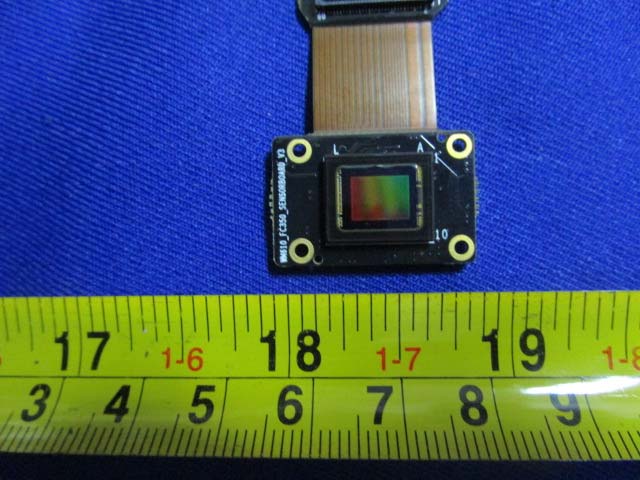
A small PCB featuring a central IC, possibly a microcontroller or sensor interface, demonstrates DJI’s precise engineering for specialized tasks. Compact layout, efficient routing, and the absence of antennas suggest this board handles specific sensor or peripheral interfacing roles. The flexible flat cable further enhances modularity and ease of integration.
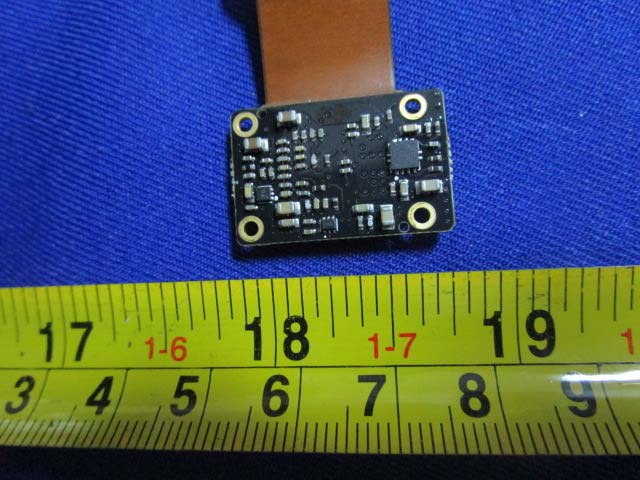
The GPS module, utilizing the Ublox M8N chip, ensures accurate positioning and navigation. Partial metal shielding protects it from electromagnetic interference, vital for GPS accuracy. Compact PCB design ensures minimal space usage, while the dedicated connector simplifies integration and maintenance.
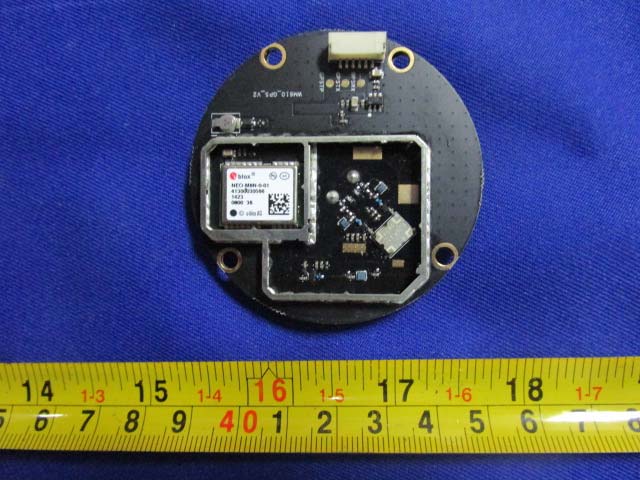
A simple PCB with minimal components and a single connector likely serves as an interface or sensor board. Its straightforward design emphasizes reliability and compactness, ideal for specialized functions within the drone’s intricate internal system.
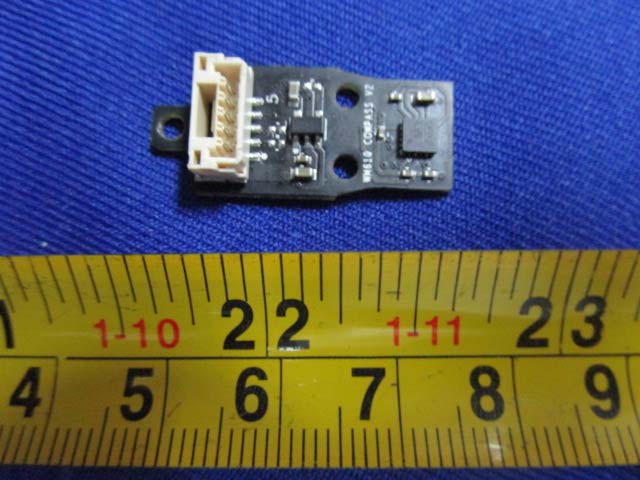
High-density PCB featuring a prominent SoC or MCU, metal shielding, and antenna connectors indicates comprehensive wireless communication and processing capabilities. Complex routing and multiple layers ensure reliable performance and robust signal integrity, crucial for drone operation.
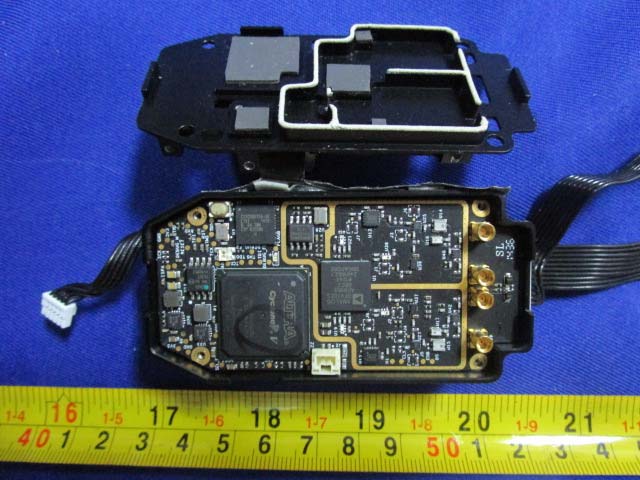
The Altera Cyclone IV FPGA highlights advanced data processing capabilities, likely managing video signals or complex flight control logic. Multiple RF antenna connectors and careful PCB routing underscore sophisticated wireless communication functionalities, essential for professional-grade drone performance.

The ANALOG DEVICES AD9363 RF transceiver, coupled with Altera FPGA, demonstrates advanced wireless communication capabilities. EMI shielding, U.FL connectors, and differential pair routing ensure high-quality RF performance, reinforcing the drone’s reliable and efficient communication systems.

Regulatory Insights & FCC Filing
FCC ID SS3-WM6101410 confirms that DJI Inspire 1 meets U.S. electromagnetic interference standards under FCC Part 15C, making it legal to sell and operate within the United States. FCC filings typically include comprehensive test reports on RF exposure, electromagnetic compatibility (EMC), internal and external photographs, manuals, schematics, and detailed block diagrams. These documents provide valuable insights into the device’s compliance, performance characteristics, and internal structure, ensuring transparency and consumer confidence.
Potential Use Cases & Target Audience
The DJI Inspire 1 serves multiple practical applications:
- Professional Videographers: Capturing cinematic aerial footage with stability and high-resolution imaging.
- Industrial Inspections: Conducting detailed inspections of infrastructure such as bridges, power lines, and buildings.
- Survey and Mapping Professionals: Accurate GPS positioning and stable flight characteristics make it ideal for mapping terrains and surveying large areas efficiently.
Conclusion
The DJI Inspire 1 (FCC ID SS3-WM6101410) exemplifies DJI’s dedication to quality, performance, and regulatory compliance. With advanced wireless communication, robust internal components, and precise engineering, the Inspire 1 remains a powerful tool for professionals seeking reliable aerial imaging solutions. Its FCC certification underlines its adherence to rigorous standards, solidifying its market position as a trusted, high-performance drone in the professional aerial imaging industry.